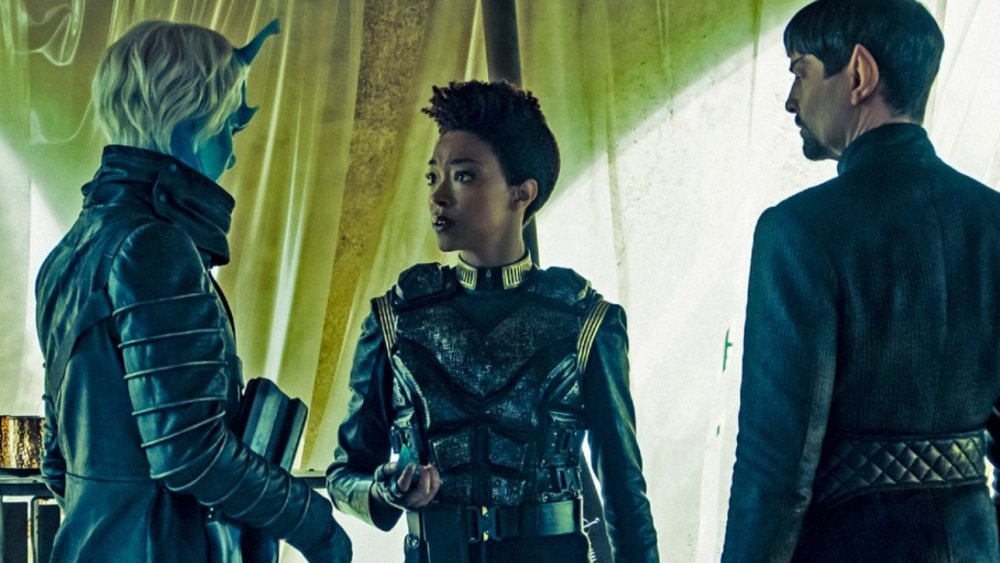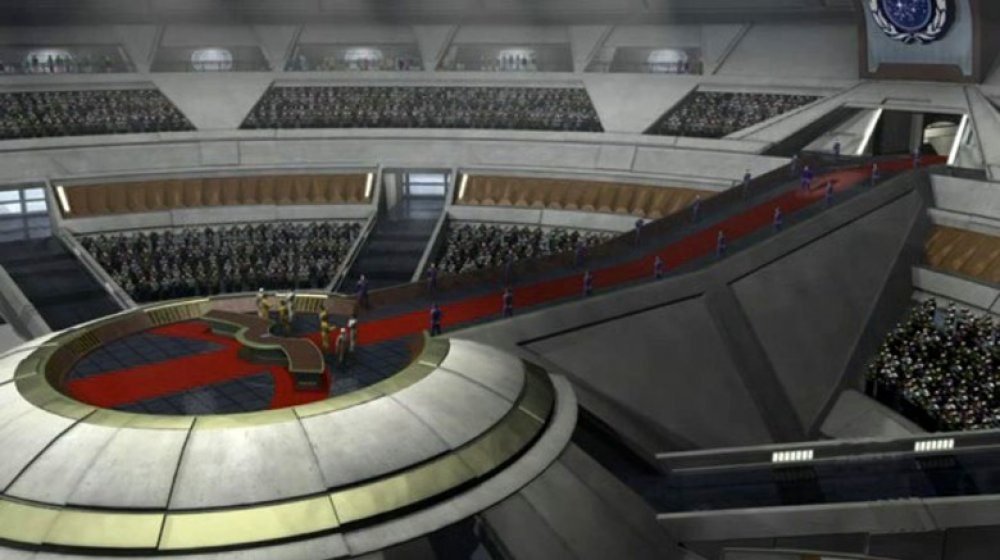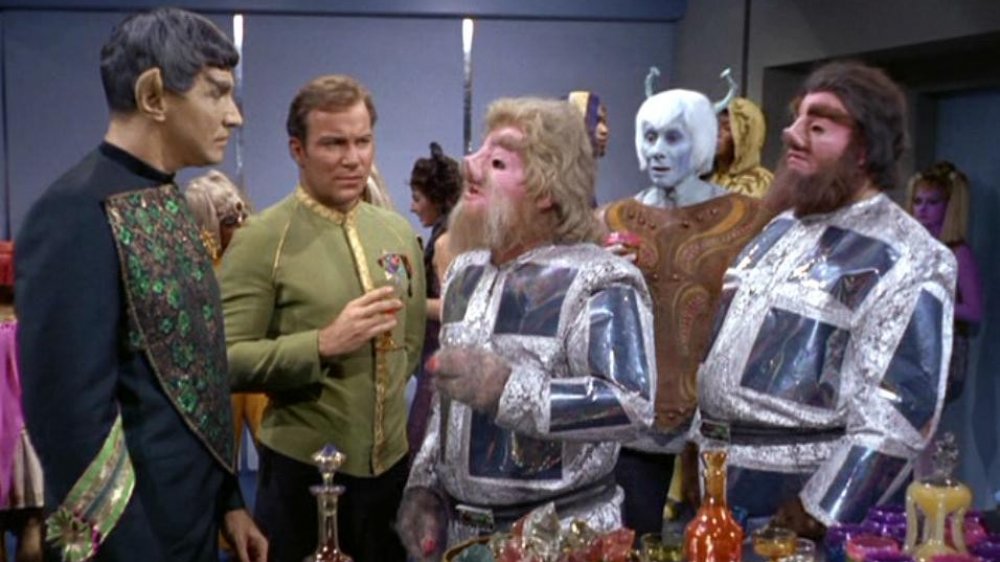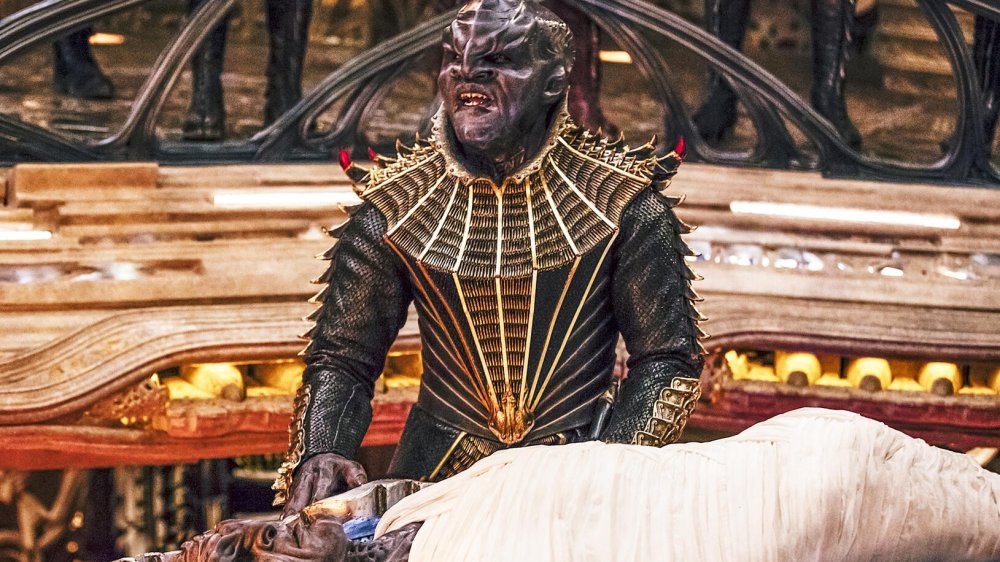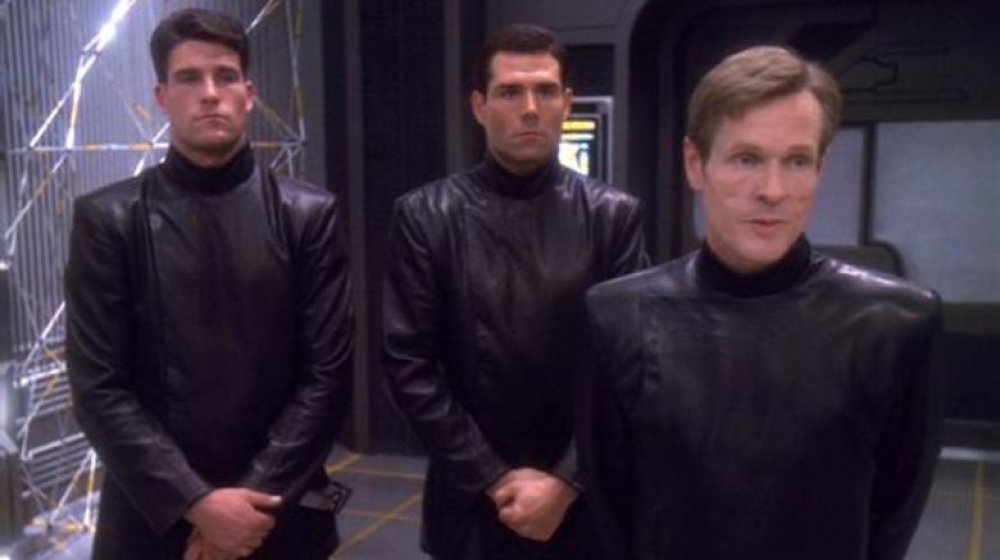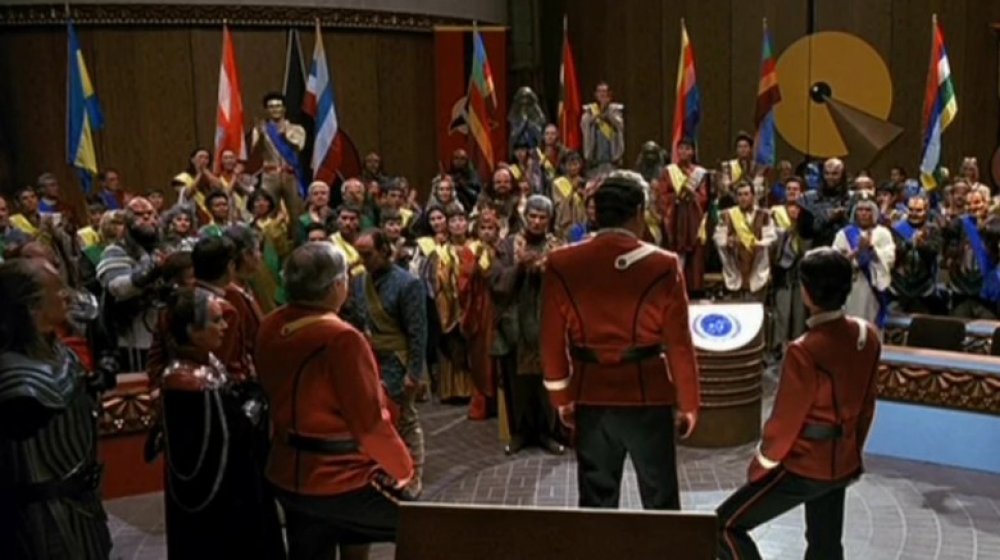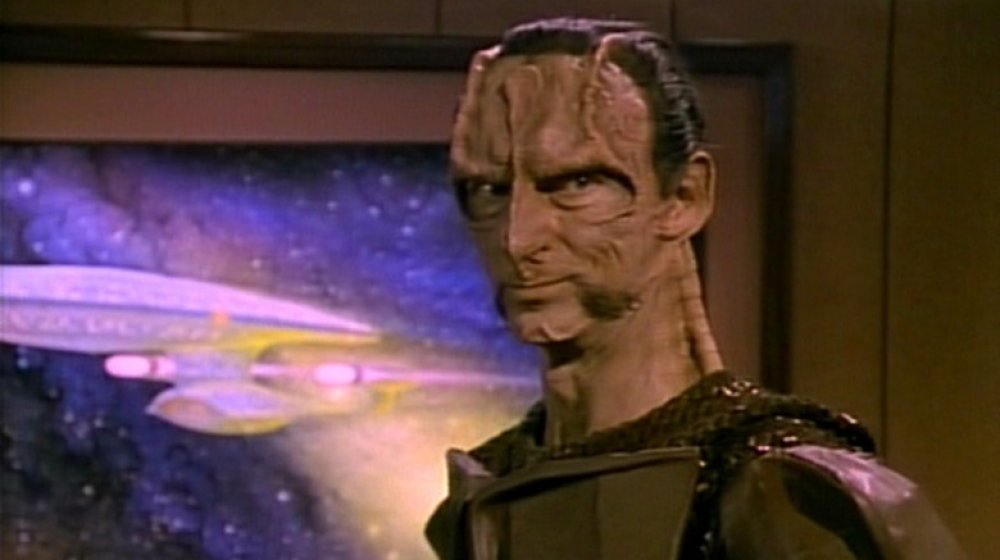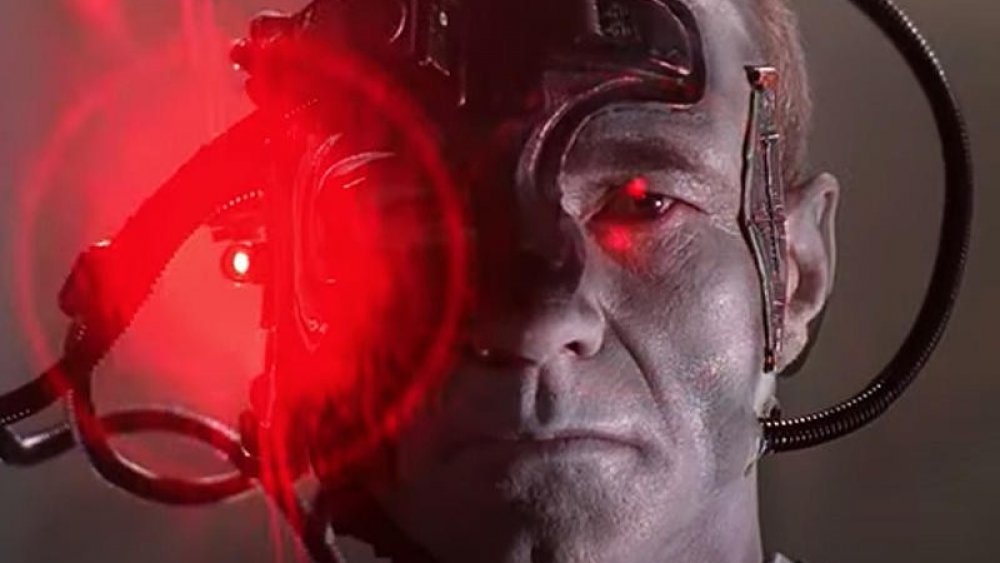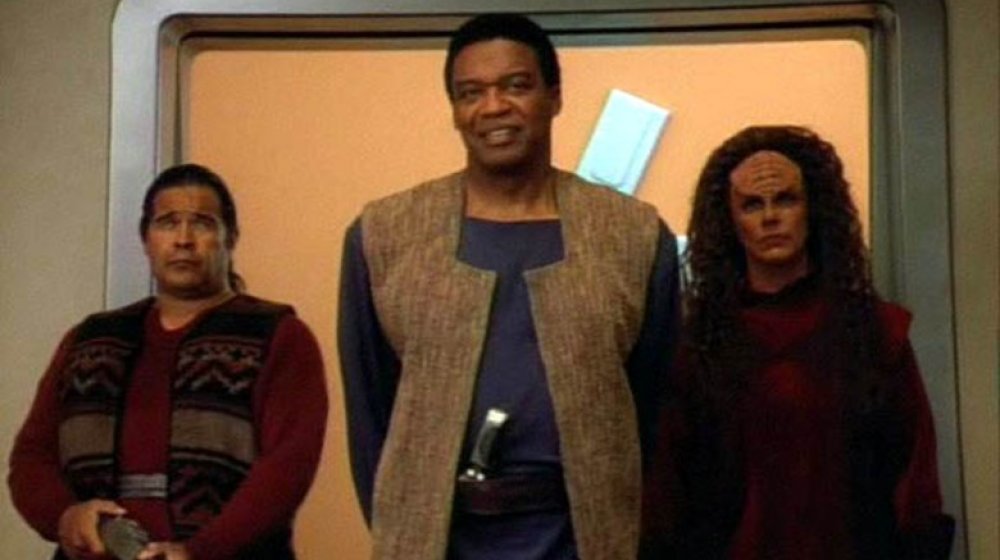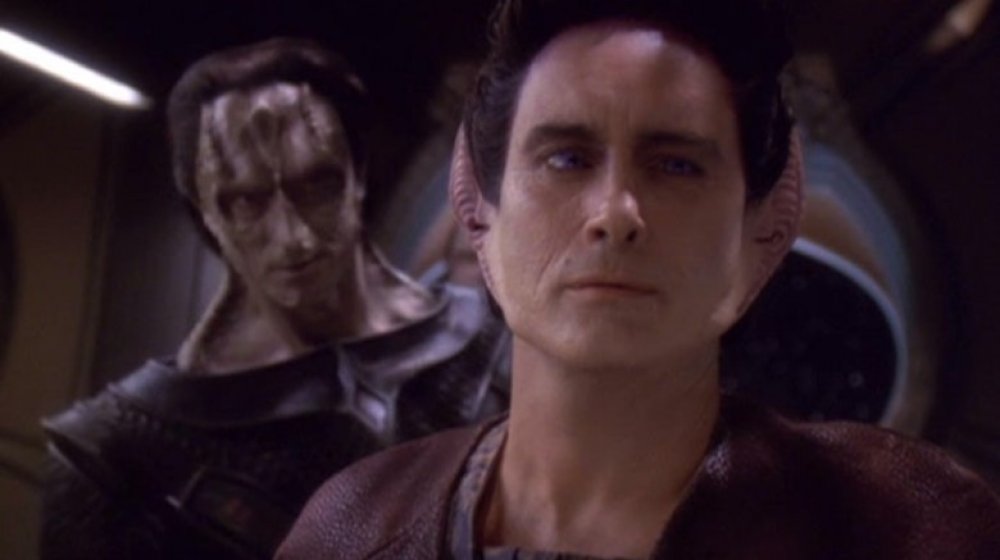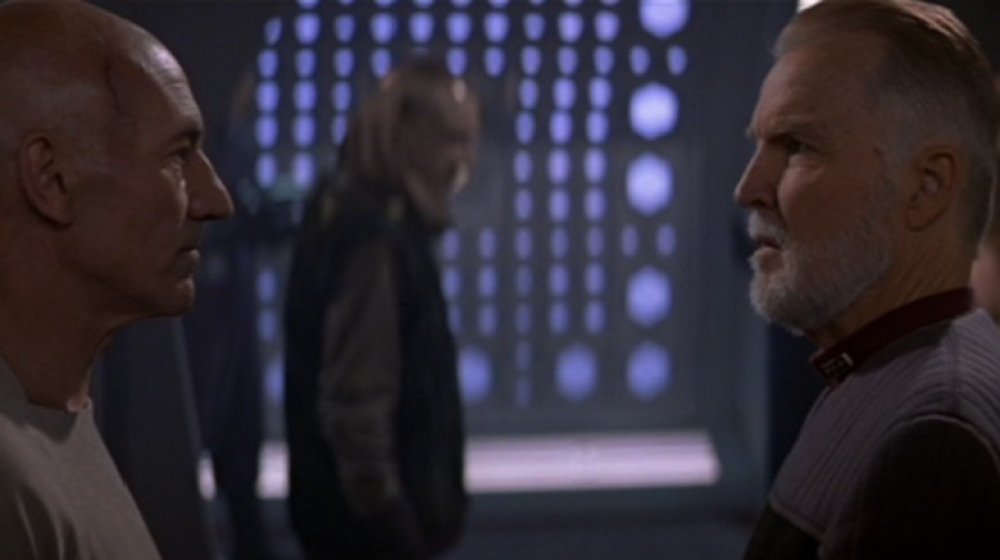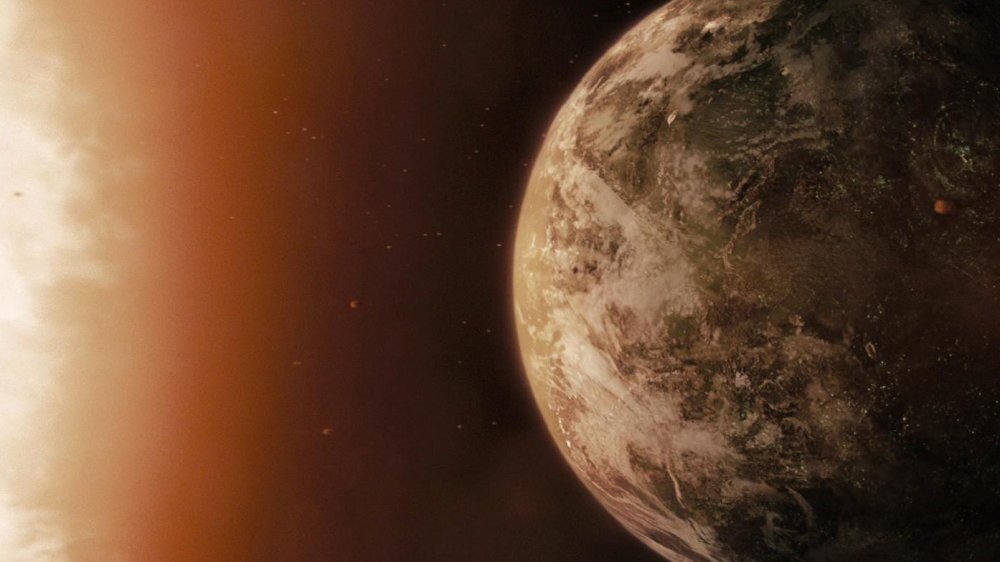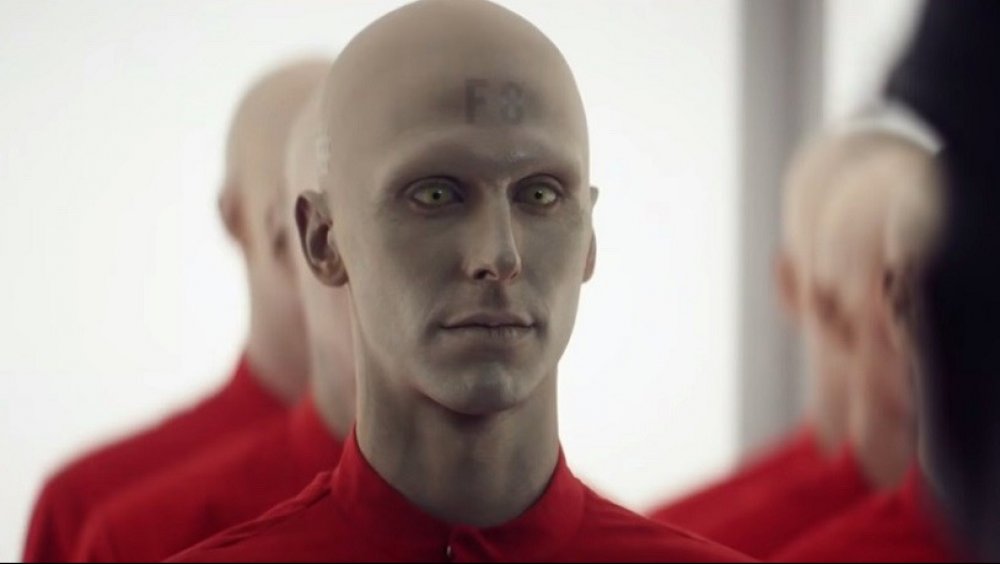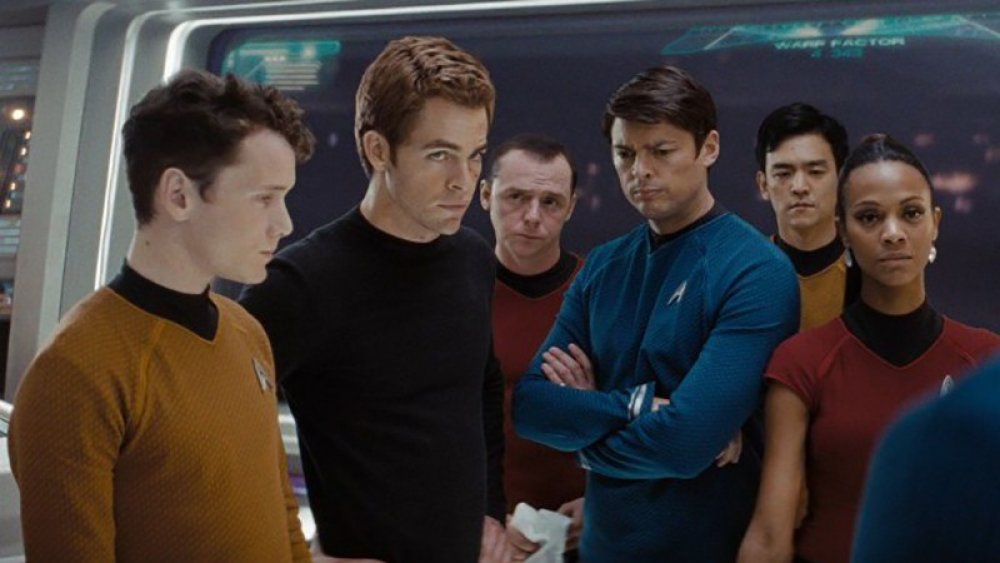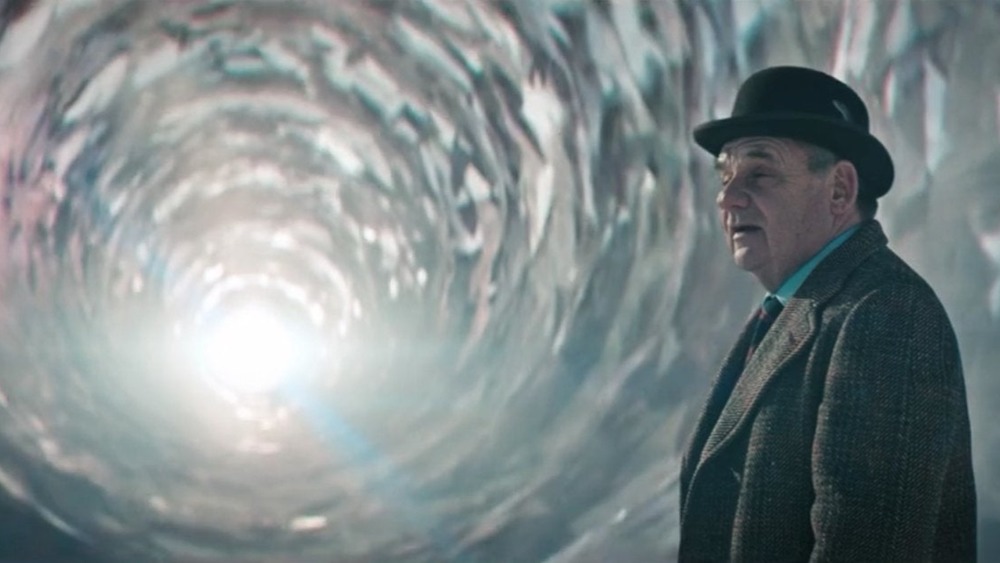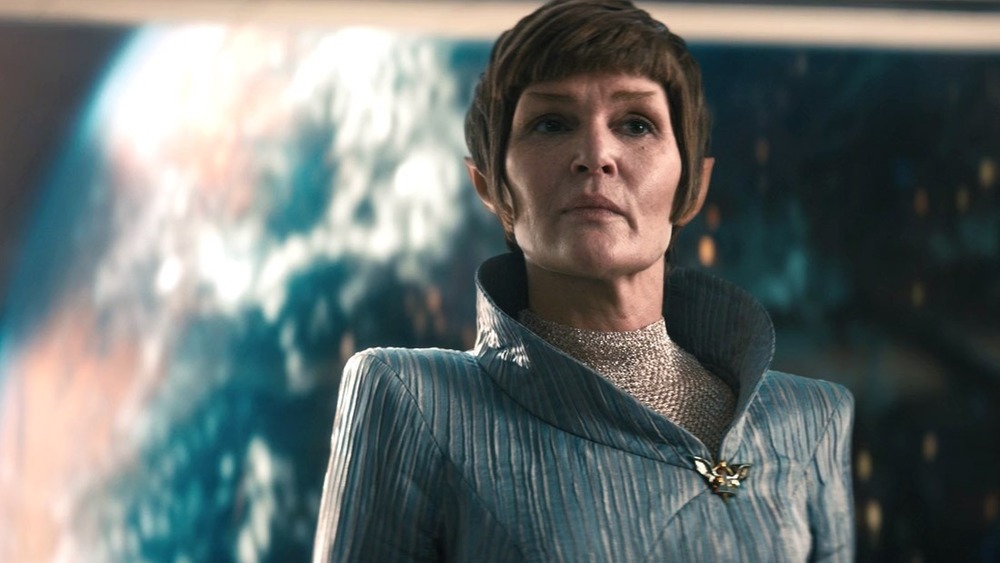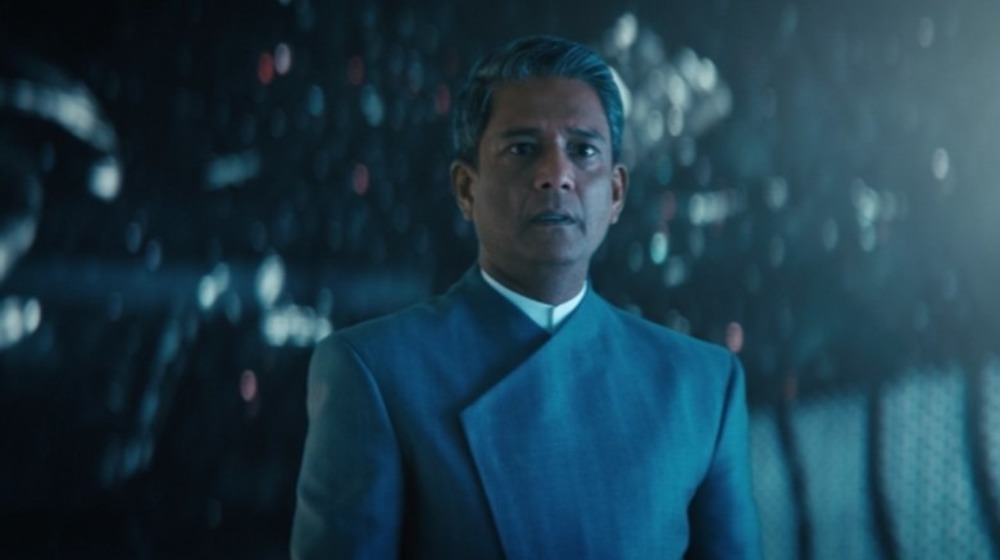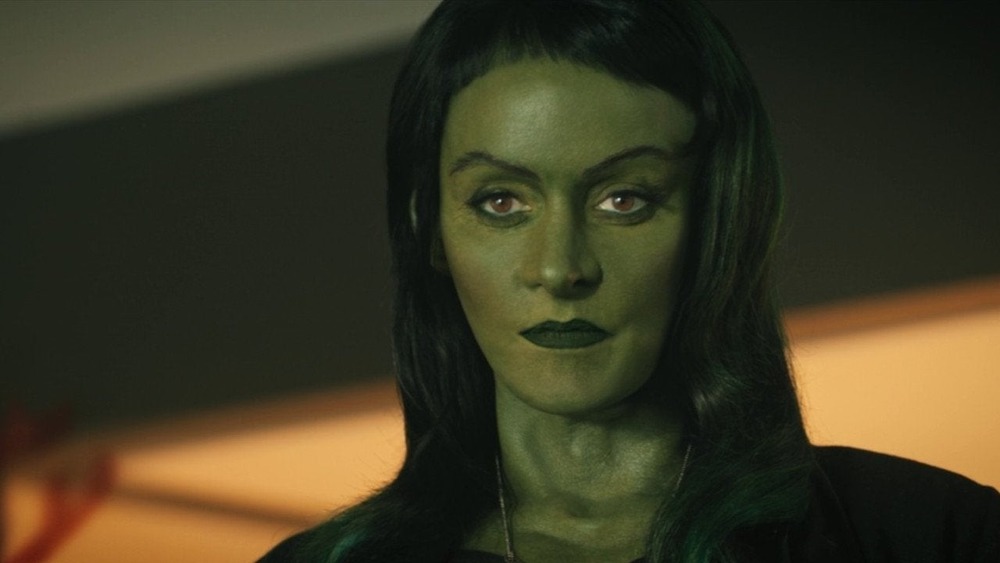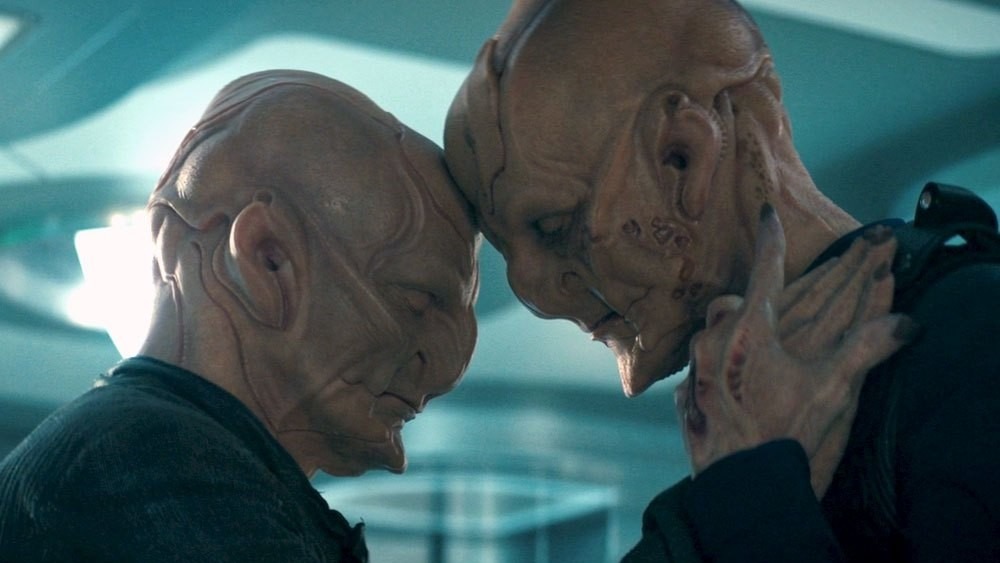The History Of The United Federation Of Planets Explained
Star Trek: The Original Series (TOS) premiered on television in 1966, and with it, Gene Roddenberry's vision was given a voice. The creator of Star Trek imagined a future cured of hunger, poverty, racism, and all social ills. Free from the challenges of their infancy, the people of Earth were able to help form the United Federation of Planets (UFP) — a central government under which dozens of alien species could enjoy liberty and equality.
While the history of the Federation would initially be used as world-building for TOS, the franchise's enduring popularity has seen the story of the Federation stretch into more media than perhaps even Roddenberry could've imagined. Passing away in 1991, Roddenberry lived long enough to see Trek expand into six major motion pictures and the revival TV series Star Trek: The Next Generation (TNG). Two more series would follow before the beginning of the new millennium, the TNG crew would get their own big-screen adventures, and more series would follow in the late 2010s. And with each new story, the pages of the Federation's history keep turning.
For more specifics on this interstellar government, keep reading for the history of the United Federation of Planets explained.
The founding of the Federation
Not surprisingly, exploring the UFP's history unearths contradictory info. Different mentions of the UFP's founding in certain episodes and films don't line up perfectly, but we get about as definitive a picture of it as we can hope for in the Star Trek: Enterprise (ENT) season 3 finale "Zero Hour," when the future is revealed to Captain Archer (Scott Bakula), and he learns he'll be a speaker at the Federation's founding ceremony.
While the number would grow much larger, only four races made up the Federation in the beginning — humans, Vulcans, Andorians, and Tellarites. That the Vulcans and Andorians were able to mend fences is nothing short of miraculous. The two races suffered an ugly rivalry, and viewers of ENT get to see quite a few examples during the series.
Together, the four races officially founded the United Federation of Planets in 2161 in San Francisco. The exact date is a matter of some debate, as non-canonical sources give different dates for the founding. Probably the closest to being official is October 11, which is the date of a news article announcing the Federation's creation. The article was made for Captain Picard's (Patrick Stewart) family album in 1994's Star Trek: Generations, but it's never seen on screen.
The Federation's principles
In 1996's Star Trek: First Contact, we learn that at that point in Trek's history — the year 2373 — the Federation has grown significantly since its founding. Over 150 member worlds make up the UFP. Obviously, the Federation hasn't been shy about courting new members since its founding. But while the Federation can be welcoming, membership is far from automatic.
In order to be considered for membership, the inhabitants of a potential member world need to achieve an impressive level of advanced technology, including developing warp technology. The planet's people must have achieved a certain level of political unity, including guaranteeing rights to all of its people. Societies tolerating prejudice based on things like gender and ethnicity have no place in the Federation. Any kind of formal social hierarchy, such as a caste system, will immediately disqualify a world from UFP membership.
Star Trek: Deep Space Nine (DS9) gives us clear examples of how a world can be denied by the Federation. In the beginning of the series, Bajor is on the brink of civil war — a signal that it's far from ready from membership. When the Bajorans briefly revive their ancient caste system of D'jarras in the season 4 episode "Accession," that alone begins to convince the Federation they're wasting their time.
The Klingon War
Even before the Federation's founding, the Klingons are less than friendly with the people of Earth. Their early meetings as chronicled in ENT are at best tense, often spilling over into violence. Almost a century after the founding of the Federation, the war-loving Klingons offer the UFP one of its direst challenges.
In Star Trek: Discovery's second episode — "The Battle of the Binary Stars," set in 2256 — T'Kuvma (Chris Obi) uses the U.S.S. Shenzhou's discovery of the Klingons' sarcophagus ship as pretense to unite the divided Houses of the Empire against the Federation. Much of the following Federation-Klingon War happens off-screen while the Discovery is stranded in the Mirror Universe. By the time they return to Trek's prime universe, they learn that after a year of warfare, the Klingons occupy approximately 80 percent of the Federation. The war ends only after L'Rell (Mary Chieffo) uses the threat of a planet-killing bomb on Qo'noS, the Klingon homeworld, to assume leadership of the Empire and halt the advance of its fleets.
This wouldn't be the last conflict between the Federation and the Klingons. In 2267, war breaks out again in TOS' "Errand of Mercy," though it doesn't last long. In 2372, after decades of peace, the Klingons lay siege to the titular space station in DS9's "The Way of the Warrior," and open war breaks out later that year. The war ends the following year after the fleets of the Dominion drive the Klingons out of Cardassia.
The Federation and Section 31
In spite of its lofty principles, the Federation isn't beyond accepting the help of the clandestine Section 31. Named for the section of the Starfleet Charter that sanctions the kind of extreme measures the organization employs, Section 31 predates the Federation. Its members are more than willing to commit crimes such as kidnapping, espionage, and murder as long as they benefit the Federation. Originally a key part of Starfleet Intelligence, Section 31 would later become an autonomous organization, which — while officially considered rogue and disavowed by the Federation — found little resistance from within the UFP.
Among the crew of the Enterprise-NX-01, Malcolm Reed (Dominic Keating) is recruited into Section 31 before the events of ENT and is brought back into the fold in the show's final season. Reed secretly hampers the Enterprise crew's investigation into the kidnapping of Dr. Phlox (John Billingsley), who Section 31 is using to cure the Klingon Augment Virus. Later, in Discovery's second season, Section 31 unwittingly becomes a threat when its artificially intelligent threat assessment system — Control — goes wild, slaughtering every Section 31 member in the group's HQ before it's neutralized.
By the time Section 31 first investigates DS9's Dr. Bashir (Alexander Siddig) on suspicion of treason over a hundred years later, most of Starfleet's rank and file have no idea who they are. Under the leadership of Luther Sloan (William Sadler), Section 31 goes on to use the Federation's temporary alliance with the Romulan Empire to manipulate a mole agent onto the Empire's powerful Continuing Committee.
The Federations and Klingons make peace at Khitomer
In the opening moments of 1991's Star Trek VI: The Undiscovered Country, the Klingon moon of Praxis — the Empire's chief energy-production facility — is destroyed, polluting the ozone of Qo'noS. Needing more resources to combat the threat to his capital, the Klingon chancellor, Gorkon (David Warner), enters talks with Captain Spock (Leonard Nimoy) in the hopes of ending the long cold war between the Klingons and the Federation.
Unfortunately, peace isn't a welcome proposition to everyone in the Alpha Quadrant. Rogue elements of the Klingon Empire, Romulan Empire, and the Federation conspire to assassinate Gorkon and kill the peace talks. Captain James T. Kirk (William Shatner) and his medical officer, Leonard McCoy (DeForest Kelley), are framed for Gorkon's murder, and the new chancellor — Gorkon's daughter Azetbur (Rosanna DeSoto) — agrees to meet with Federation representatives at the Khitomer Conference. With the combined efforts of the Enterprise-A and the Excelsior, the plot is uncovered, Kirk and McCoy are proven innocent, and the conference is a success.
For close to a century, the Federation and Klingon Empire enjoy peace. While the Empire does away with the Khitomer Accords briefly in season 5 of DS9, it would soon renew them to join the UFP in their war against the Dominion.
Wars, conflicts, and crises
Throughout its history, the UFP faces a number of wars and conflicts involving its neighbors, though most of these events take place off-screen. Since viewers only hear about these incidents after the fact, we don't have a lot of hard information regarding the when or even the why. Perhaps the most significant of these is the Earth-Romulan War, which begins before the Federation's founding. In fact, the war proves to be one of the events that inspire the people of Earth, Tellar Prime, Vulcan, and Andoria to form the UFP. However, the Romulans would go on to play chess with the Federation in both combat and espionage for centuries to come.
First seen in TNG, the Cardassians would also be a major rival to the Federation. By the time we meet them in TNG's "The Wounded," a peace treaty is newly established between the rivals after a war spanning two decades. While the two powers don't make war on each other again until the end of DS9's fifth season — by which time Cardassia has joined the Dominion — there's still espionage and isolated pockets of conflict between them.
The Borg tries to absorb the Federation
In TNG's "Q Who," the mischievous Q (John de Lancie) arranges a meeting between the Enterprise-D and the Borg — a hive-like collective of cybernetic beings who assimilate other species into their collective, believing that with each new species it assimilates, the Borg come closer to perfection. And so in 2366 — in the TNG two-parter "The Best of Both Worlds" — the Borg come steaming into Federation space. They capture Picard and assimilate him, using his knowledge to combat the Federation. The crew of the Enterprise eventually rescues Picard and stops the Borg Cube but not before invading Borg destroy 39 Federation and Klingon warships at the Battle of Wolf 359.
The Borg return in First Contact with a different plan. This time, the Enterprise-E leads a fleet that destroys the attacking Borg Cube, but before its destruction, it ejects a sphere that travels back in time to the 21st century with the goal of assimilating Earth before its people can achieve warp capability, thereby stopping the Federation's founding. Thankfully, Picard and his crew are able to stop the Borg once more.
In the Star Trek: Voyager series finale, the Borg is severely crippled by a Kathryn Janeway (Kate Mulgrew) of an alternate timeline who infects the collective with a pathogen that kills the Borg Queen (Alice Krige). However, the presence of a Borg Cube in Star Trek: Picard lets us know that decades later, the collective still exists.
The Maquis rebel against the Federation
You don't hear of many groups of Federation citizens wanting to leave it or rebel against it. That changes toward the end of DS9's second season. Among other things, the 2367 treaty between the Federation and Cardassia allows the latter to annex certain UFP worlds, and some of the UFP citizens on those worlds refuse to leave. Feeling forgotten by their own people and abused by the Cardassians, some UFP citizens join the Maquis — a paramilitary group waging guerrilla war on Cardassians in the demilitarized zone.
While the Maquis prefer to fight Cardassians, they do come in conflict with the Federation on a number of occasions. Michael Eddington (Kenneth Marshall) starts off as a recurring Starfleet officer on DS9 who eventually reveals himself to be a leader in the Maquis sent to infiltrate the space station. William Riker's (Jonathan Frakes) doppelganger, Thomas Riker, joins the Maquis and uses his "brother's" identity to steal the Defiant in DS9's third season, using it to assault Cardassian ships and outposts. However, the Maquis is all but wiped out in DS9's fifth season when the Dominion enters the Alpha Quadrant and drives the group to near extinction.
The Dominion and the Federation go to war
Not long after the discovery of a stable wormhole near Bajor, the Federation faces its greatest military challenge — the Dominion. The Federation makes its first official contact with the Dominion in 2370 with the DS9 season 2 finale "The Jem'Hadar." At first, the clash between the two powers is limited to smaller conflicts, but open war breaks out with the season 5 finale "Call to Arms."
The war is long and costly, with the Dominion finding powerful allies in Federation neighbors like the Cardassians and the enigmatic Breen. At first, the Federation and Klingon alliance seems doomed, but they're given an unexpected respite when the Prophets — powerful aliens living inside the wormhole — destroy the Dominion's reinforcement fleet on its way from the Gamma Quadrant. The Romulan Empire joins the UFP and Klingons, and the Dominion is finally defeated in the DS9 series finale.
While there are other races who appear as minor members, the Dominion is made up primarily of three species. The Jem'Hadar are powerful and skilled soldiers kept in check with the addictive substance ketracel-white. Above them are the cunning Vorta, who are trained in the arts of diplomacy and strategy. Finally, there are the shape-shifting Changelings, also known as the Founders. The Founders created the Dominion to impose their order throughout the galaxy. Along with leading the Dominion, their shape-changing abilities allow them to more easily infiltrate the highest echelons of their enemies' hierarchies and attack them from within.
The Federation's principles are tested
The Dominion War put the Federation's principles to the test, and in some cases, its most hallowed heroes failed that test.
Perhaps the most infamous example is Captain Sisko's complicity in the assassination of a Romulan senator in DS9's "In the Pale Moonlight." The Cardassan exile Garak (Andrew Robinson) fools Sisko into believing the purpose of bringing Senator Vreenak (Stephen McHattie) to DS9 is to convince him the Dominion is planning an attack on Romulus. In fact, Garak assassinates the senator and successfully frames the Dominion for the killing, bringing the Romulans into the war on the Federation's side. Though furious at Garak's crimes, Sisko keeps the truth to himself in order to win the war.
Likewise, in 1998's Star Trek: Insurrection, we see more examples of the Federation bending its rules because of pressure from its adversaries. Early in the film, we learn the UFP has accepted the Evora into the fold even though they barely meet the minimum requirements for Federation membership, precisely because the losses the UFP has suffered at the hands of the Dominion and the Borg. And as the rest of the film unfolds, it's clear the Federation would never have agreed to working with the deceptive and unethical Son'a if it weren't for the desperate straits in which it finds itself.
The Federation and the Romulan supernova
In the 2380s, the Romulan Empire — upon learning its sun will go supernova — reaches out to the Federation for help in evacuating its territory. At the behest of Jean-Luc Picard, now an admiral, and in spite of centuries of hostility and some of its member races threatening to leave, the Federation embarks on a massive rescue operation.
The evacuation ends tragically, however, after synthetic workers at the Utopia Planitia Fleet Yards on Mars — where the evacuation fleet is being built — go rogue, destroying the fleet and killing over 90,000 Federation citizens. In the wake of the attack, the Federation pulls out of the evacuation, and Admiral Picard resigns from Starfleet in protest.
The evacuation attempt isn't the only solution attempted to save Romulus. Ambassador Spock theorizes he can create a black hole that will absorb the sun's energy, but Spock's arrival proves too late. Romulus is destroyed, killing everyone trapped on the planet.
The Federation bans A.I. lifeforms
The Federation's withdrawal from the Romulan evacuation isn't the only far-reaching consequence of the rogue synths' attack on Mars. After the deaths of so many of its citizens, the UFP bans all synthetic lifeforms. Beings like the late Lieutenant Commander Data (Brent Spiner) — who sacrificed himself to save the Enterprise at the end of 2002's Star Trek: Nemesis – may no longer live in the UFP's borders or serve in Starfleet.
In Picard, the titular hero discovers the attack that prompted the synthetic ban wasn't what it seemed. The Mars massacre was orchestrated by the Zhat Vash — a clandestine Romulan organization committed to wiping out all synthetic life because of their belief in the coming of a galactic apocalypse at the hands of synthetic beings.
In the season 1 finale of Picard, Jean-Luc and his friends are able to uncover the Zhat Vash plot and stop the Romulans from destroying the synthetic homeworld of Coppelius. After the Zhat Vash's schemes are unveiled, the Federation ban on synthetic lifeforms is lifted.
The Kelvin Timeline
The destruction of Romulus directly leads to the creation of the so-called "Kelvin Timeline," in which the history of the Federation goes down different roads.
In 2009's Star Trek, we see the birth of the Kelvin Timeline. After creating a black hole in an attempt to absorb the energy of the Romulan sun and save Romulus, Spock is confronted by the Narada, a Romulan mining vessel captained by the vengeful Nero (Eric Bana) whose family died during the supernova. Both the Narada and Spock's ship are sucked into the black hole and sent back in time. The Narada appears in the year 2233 where it immediately destroys the U.S.S. Kelvin and, in doing so, creates a new timeline.
Among some of the major differences between the Kelvin Timeline and the Prime Timeline is the destruction of Vulcan at Nero's hands. This alternate version of the Federation also proves to be much more focused on military threats, leading Starfleet to discover the exiled warlord Khan Noonien Singh (Benedict Cumberbatch) much earlier than in the Prime Timeline and blackmailing him into their service.
The Federation pays a high toll during the Temporal Wars
In order to stop the rogue A.I. threat assessment system Control from destroying all life in the galaxy, the crew of the Discovery jumps 900 years into the future to the 32nd century at the end of the show's second season. After reconnecting with the UFP of that time in season 3, they learn that one of the more important historical events of the last few centuries has been the Temporal War.
We don't know a lot of details about the war but — assuming it's the same war referenced throughout ENT — it begins in the 29th century and involves multiple factions including the Cabal, the Na'Kuhl, and the Federation, among others. In Discovery's "Terra Firma, Part 1" we learn it also involved at least one Starfleet officer from a parallel reality. We also learn at least one faction, possibly more, sought out the Guardian of Forever — the sentient portal which transports Kirk, Spock, and McCoy to 20th century Earth in TOS' "The City on the Edge of Forever" — to use its abilities in the war. Not pleased with being used to spread destruction and death, the Guardian moves in secret from the unnamed planet upon which Starfleet first finds it to Dannus V.
While we don't know the extent of the war's casualties, it was bad enough for the Federation to outlaw all time travel without exception.
The Vulcans and the Romulans reunite
In the 23rd century during the two-part TNG episode "Unification," Spock — now a Federation ambassador — disappears and is spotted on Romulus. While the UFP initially fears Spock has defected, it eventually comes to light that he's there to help a still-young movement with the goal of brining the Vulcans and Romulans back together as one people.
Sadly, Spock doesn't stay in the Prime timeline long enough to see it happen, but sometime between the 24th and 32nd centuries, his dream comes to fruition. Romulans return to Vulcan, and both people agree to acknowledge this rejoining by renaming the planet Ni'Var. A term coined by linguist Dorothy Jones who reportedly created the first Vulcan language, Ni'Var means "two form." Noted Star Trek fanzine writer Claire Gabriel used the word for an unpublished novel which would later be renamed The Thousandth Man.
At some point before Discovery's third season, Ni'Var leaves the Federation. Discovery season 3 implies the chief reason for their departure is their incorrect assumption that scientific experiments the UFP pressures them to perform are responsible for a galactic cataclysm. However, Ni'Var's President T'Rina (Tara Rosling) says it was one of many reasons. She doesn't get very specific, but it becomes clear that Ni'Var suffers from fierce divisions between three major factions — Vulcans, Romulans, and those with shared ancestry.
The Burn fractures the Federation
After arriving in the 32nd century, Michael Burnham and the Discovery crew soon learn perhaps the most significant event to occur in the last 900 years is something known as the Burn. For reasons initially unknown, at some point in the late 31st century, almost all the dilithium in the galaxy stops working, causing the warp cores on an untold number of active space vessels to detonate. No one knows how many die, only that the number is somewhere in the millions.
Along with the loss of life, the UFP becomes much smaller. With dilithium suddenly becoming perhaps the single most scarce and valuable resource in the galaxy, the Federation's ability to contact and protect its member planets is crippled. Fleet Admiral Charles Vance (Oded Fehr) says that at one point, the UFP had over 350 member planets. The Burn helps to chop that number down to around 38 by the 32nd century, though there are other worlds that may still consider themselves UFP members that Starfleet simply can't reach. Among those planets the UFP loses to the Burn are Trill and one of its founding members, Earth itself.
The Burn also helps make way for the rise of the Emerald Chain — a group of mercantile exchanges which fills the void the UFP leads behind, while at the same threatening planets with famine or worse if they don't bend the knee, and in some cases forcing people into slavery.
The Federation goes to war with the Emerald Chain
At the end of Discovery's third season, Minister Osyraa (Janet Kidder) of the Emerald Chain captures the titular vessel in a desperate attempt to forge a union with the UFP. She uses the ship to be allowed into the protective shield of Starfleet's headquarters, later explaining she does it because she wouldn't be allowed in any other way.
In Starfleet headquarters, Osyraa negotiates with Admiral Vance to bring the UFP and the Emerald Chain together into one entity, arguing they can only survive that way. She's prepared an in-depth armistice, which includes rollbacks to Emerald Chain practices that go against the Federation charter such as slavery. Understandably suspicious at first, Vance eventually seems ready to give the document his seal of approval, but the sticking point proves to be Osyraa herself. Vance demands that — in order for the armistice to be more than an empty document — Osyraa must be tried for her crimes.
Predictably, Osyraa refuses and attempts to leave with Discovery and her valuable spore drive. A heated starship battle ensues, with every ship at Starfleet HQ opening fire on the Discovery. With help from Discovery's actual crew and a fleet of ships from Ni'Var, Michael Burnham kills Osyraa, the Discovery returns to Starfleet's control, and Osyraa's warship the Viridian is destroyed. We have yet to see how the Emerald Chain will respond.
Solving the Burn begins to heal the Federation
Michael Burnham makes it her goal to figure out what caused the Burn in Discovery's third season, believing the UFP can only begin to heal when that answer is found. From what we see in the season finale, Burnham is right.
The Burn, surprisingly, is triggered by a young boy's trauma. By the later 31st century, the Kelpiens have joined the UFP. A Kelpien ship, the Kh'ieth, travels into the Verubin Nebula to study a planet rich with dilithium, but crashes on the planet and is unable to leave or contact anyone outside the nebula. While there, the Kelpien scientist Doctor Issa gives birth to a young boy — Su'Kal. Somehow, because he is in utero on the planet and later born there, Su'Kal has some kind of connection with the dilithium and at the same time is immune to the radiation it produces. When his mother finally succumbs to radiation exposure and dies, Su'Kal's trauma — unbeknownst to him — causes a chain reaction through most of the galaxy's dilithium. After the Discovery crew finds the adult Su'Kal (Bill Irwin) and rescues him, they learn the truth.
As Burnham predicts, with both the secret of the Burn revealed and Discovery's spore drive at its disposal to help reconnect with the galaxy, the Federation begins to heal. By the end of Discovery's third season, the Trill have rejoined the UFP. While Ni'Var hasn't rejoined yet, we see President T'Rina has reopened regular diplomatic relations with the UFP.
